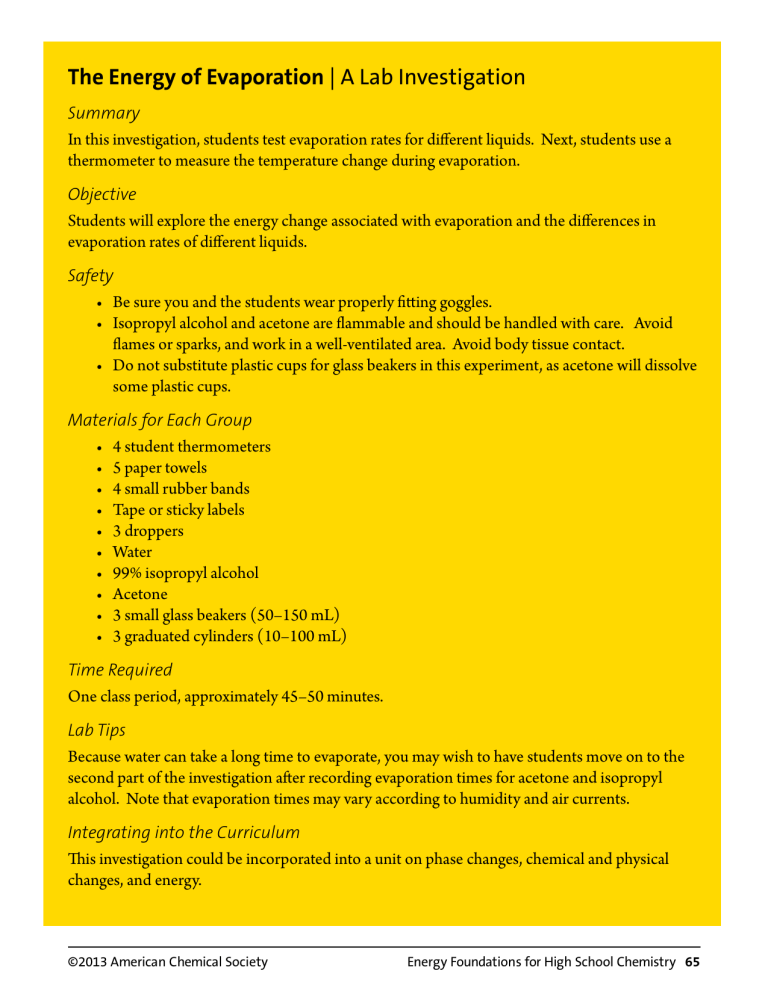the Energy of Evaporation | A Lab Investigation

the Energy of Evaporation | A Lab Investigation
Summary
In this investigation, students test evaporation rates for different liquids. Next, students use a thermometer to measure the temperature change during evaporation.
Objective
Students will explore the energy change associated with evaporation and the differences in evaporation rates of different liquids.
Safety
•
•
•
Be sure you and the students wear properly fitting goggles.
Isopropyl alcohol and acetone are flammable and should be handled with care. Avoid flames or sparks, and work in a well-ventilated area. Avoid body tissue contact.
Do not substitute plastic cups for glass beakers in this experiment, as acetone will dissolve some plastic cups.
•
•
•
•
•
•
•
•
•
•
Materials for Each Group
4 student thermometers
5 paper towels
4 small rubber bands
Tape or sticky labels
3 droppers
Water
99% isopropyl alcohol
Acetone
3 small glass beakers (50–150 mL)
3 graduated cylinders (10–100 mL)
Time Required
One class period, approximately 45–50 minutes.
Lab Tips
Because water can take a long time to evaporate, you may wish to have students move on to the second part of the investigation after recording evaporation times for acetone and isopropyl alcohol. Note that evaporation times may vary according to humidity and air currents.
Integrating into the Curriculum
This investigation could be incorporated into a unit on phase changes, chemical and physical changes, and energy.
©2013 American Chemical Society Energy Foundations for High School Chemistry 65
tEachEr’s KEy
Analyzing Evidence
1. Complete Table 2 using your observations from the experiment. Enter either a plus (+) or minus (−) sign in the last column of the table for the change in energy of the liquid dampened paper towel in each case.
Table 1. Evaporation test results
Liquid Water
Time (minutes) 10:00
Isopropyl alcohol
3:00
Acetone
0:52
Table 2. Energy change during evaporation results
1. Water
Liquid T i
24 °C
2.
3.
Isopropyl alcohol
Acetone
24 °C
24 °C
4. Control 24 °C
T f
18 °C
15 °C
6 °C
24 °C
ΔT
−6 °C
−11 °C
−18 °C
0 °C
ΔE (+/−)
−
−
−
N/A
Interpreting Evidence
1. Using the space-filling models below as a guide, write the chemical formulas for (1) water,
(2) isopropyl alcohol, and (3) acetone.
Water—H
2
O
HOH
Isopropyl alcohol—C
3
H
8
(CH
3
)
2
O Acetone—C
3
CHOH (CH
3
)
2
H
CO
6
O
©2013 American Chemical Society Energy Foundations for High School Chemistry 71
2. Using the language of intermolecular forces, explain the order of the evaporation rates you observed in the first part of your experiment.
Acetone has the weakest intermolecular forces, so it evaporated most quickly. Water had the strongest intermolecular forces and evaporated most slowly. The strength of the intermolecular forces in isopropyl alcohol are in between water and acetone, but probably closer to acetone because the water took much longer to evaporate.
3. What differences in intermolecular forces might explain the differences in the time it takes water, isopropyl alcohol, and acetone to evaporate?
Water evaporates most slowly because its molecules are attracted to one another by hydrogen bonding. Acetone does not participate in hydrogen bonding, so its intermolecular forces are comparatively weaker, and it evaporates most quickly. Isopropyl alcohol can also participate in hydrogen bonding, but not as successfully as water because it has a non-polar region, so it evaporates at an intermediate rate.
4. Using the language of intermolecular forces and energy, explain why you observed the temperature changes that you did in the second part of your experiment.
The temperature decreased for each of the liquid-soaked paper towels in the experiment because evaporation is a phase change that absorbs energy.
During evaporation, some fast-moving, highly energetic molecules have enough energy to overcome the attractions that individual molecules have for one another and enter the gas phase. As these high-energy molecules leave the liquid phase, the average energy of the remaining liquid molecules is lowered and the temperature goes down. Because the liquid is now at a lower temperature than its surroundings, it continues to absorb energy from its surroundings to keep evaporation going.
We observe energy being absorbed by a liquid as it evaporates as a decrease in temperature of the liquid and in its surroundings as they transfer energy to the liquid.
5. Draw and label energy diagrams for the evaporation of equal amounts (same number of moles) of water, acetone, and isopropyl alcohol. How are the energy diagrams different from one another?
These diagrams show the relative energy levels for the same number of moles of each liquid and its vapor at the same temperature. All of the diagrams show that the process of evaporation absorbs energy. Water absorbs the most energy, acetone absorbs the least energy, and isopropyl alcohol is somewhere in between.
72 Energy Foundations for High School Chemistry ©2013 American Chemical Society
Water (H
HOH
2
O) Isopropyl alcohol
(C
3
H
8
O)
Acetone
(C
3
H
6
O)
Reflecting on the Investigation
1. Is evaporation a cooling process or a heating process? Explain your answer in terms of energy and intermolecular forces.
Evaporation is a cooling process. In the liquid state, molecules are closer together than they are in the gas state. Energy is required to separate these molecules of a liquid as they become farther apart in the gas phase. The amount of energy absorbed by the liquid must be enough to overcome the attractions that the molecules of the liquid have for each other.
2. Given what you’ve learned in this investigation, why do you think people sweat?
People sweat as a means of temperature regulation. Sweating keeps us cool. As our sweat evaporates, it absorbs energy from our skin, which cools us down. Sweating is a form of “evaporative cooling.”
3. In this investigation, you have seen that evaporation is a cooling process. Condensation is the opposite of evaporation—water in the vapor phase condenses to form liquid water.
Using the language of energy and intermolecular attraction, explain why condensation is considered a warming process. Draw an energy diagram for the process of condensation.
Condensation is a warming process because energy is released as molecules in the gas phase come closer together in the liquid phase. Because molecules are attracted to one another, they are at lower energy when they are closer together (as they are in the liquid phase) than when they are further apart (in the gas phase). This transition from high energy to low energy releases heat to the surroundings.
©2013 American Chemical Society Energy Foundations for High School Chemistry 73
Post-Lab Discussion
This investigation can also be helpful to illustrate the relationship between temperature and energy. Consider showing the video “Temperature and Energy” from the Energy Foundations collection.
Extensions
To more fully explore phase changes in water, you may consider pairing this investigation with constructing a heating curve for water. Several different procedures are available online:
•
• http://bit.ly/highschoolnrg11 http://bit.ly/highschoolnrg12
Additional Resources
“Water: A Natural Wonder,” Chemistry: A Project of the American Chemical Society . New York:
W. H. Freeman and Company, 2005, pp 1 –71.
74 Energy Foundations for High School Chemistry ©2013 American Chemical Society







